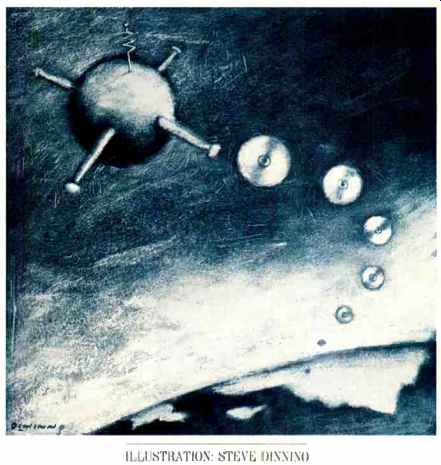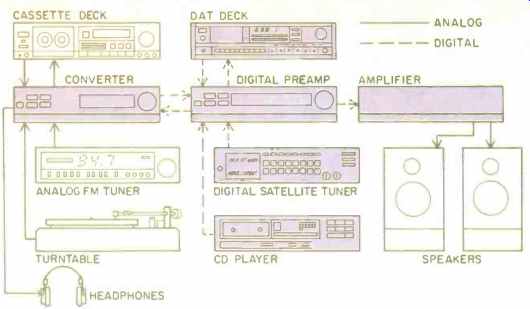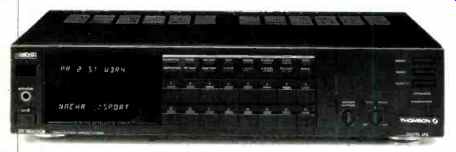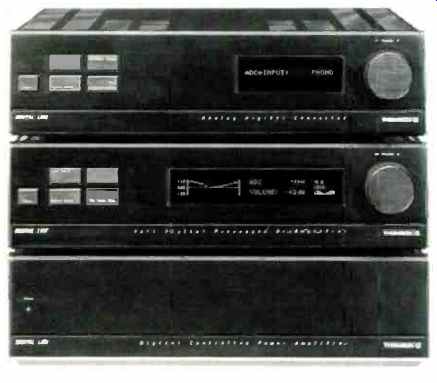
by Robert Agnus
Now that we've got the digital Compact Disc and Digital Audio Tape is clearly on the horizon, we need only one more program source-digital radio-to complete the transition from 100 years of analog.
And that source may be nearer at hand than you think.
At the 1989 International Funkausstellung, an audio/video festival held biennially in Berlin, the big news was digital audio from satellite, with tuners from such companies as Philips, Telefunken, Thomson, and Grundig to receive it. Not only did these manufacturers show state-of-the-art tuners, but most had digital components and rack systems to accompany them.
In the United States, digital radio may be no farther away than your cable box, and may arrive not much later than the first quarter of this year. No fewer than three companies--the Jerrold Division of General Instrument, Digital Radio Labs, and International Cablecasting Technologies--are trying to convince cable operators to add digital music to their lineups. One company has already talked Marantz into signing on to provide the necessary reception equipment.
The trouble is, the three American digital formats are incompatible with one another and with the European format. None is suitable for over-the-air transmission, even assuming that some FM license-holder could be persuaded to give up profitable air time to try it.
Even more of a problem, from the American audiophile's point of view, is that the decision about which system he'll be able to get will be made neither by the Federal Communications Commission nor the nation's FM broadcasters, but by local cable operators. And the decision is much more likely to be based on economic considerations than on technical merits.
What made digital audio practical in Europe was the launch in 1989 of the Kopernikus satellite, which carries 16 stereo programs or 32 mono signals--each with the sound quality of a Compact Disc. The tuners all feature 16 pushbuttons, one for each stereo pair.
Programming is provided by independent broadcasters who, like their North American counterparts, generally concentrate on a particular music format.
For example, available channels offer news and talk, easy listening, classical music, Top 40, and so on. Instead of displaying frequency, a front-panel LCD readout shows which format has been selected. If a user selects "News," for example, and none can be received, the tuner will wait silently until a news program becomes available, then turn itself on and switch to the appropriate channel.
Typical of the new units is Thomson's DT 1000 DSR, for which the manufacturer claims a transmission range of 10 Hz to 15 kHz, a dynamic range of 92 dB, stereo channel separation in excess of 80 dB, and signal-to-noise ratio (A-weighted) of 110 dB. Designed for European cable formats, it receives a signal transmitted via satellite at 118 MHz, using "4 PSK" (four-phase shift keying) modulation. The audio signals are reproduced with 16-bit dynamic range, and sampling frequency is 32 kHz. Oversampling, digital filtering, and two digital/analog converters recover the audio signals.
Accompanying this tuner--and similar units from Philips, from Grundig, and from Telefunken--are packages of all-digital units ranging from DAT decks and CD players to a digital-line A/D converter, preamp, and power amp, all connected either by fiber-optic cable or conventional coaxial cable.
While some of these packages consist of individual components, others are rack systems designed to operate with a single infrared remote control.
Thomson's Digital Line takes this trend even further, with components interconnected only via digital fiber optics. At the top of this line is a three-piece amplification system consisting of an Analog Digital Converter, a Full Digital Processed Pre-Amplifier, and a Digital Controlled Power Amplifier. All analog components are connected to the converter unit, which has seven analog input pairs, a 16-bit ND converter with input oversampling, and a 16-bit D/A converter with eight-bit oversampling to feed the unit's analog tape output and headphone jacks. A multi-function knob can be used for headphone volume and to independently select signals to be recorded, passed on to the preamp and amp for listening, and sent to the headphone jacks. The knob's current function (selected by a keypad) and that function's status are shown on an alphanumeric display.

Digital and analog interconnections of the Digital Line.

Thomson's DT 1000 DSR tuner, for Europe's new digital
audio satellite service.

The three top components of Thomson's Digital Line:
Analog Digital Converter, Full Digital Processed Pre-Amplifier, and Digital
Controlled Power Amplifier.
Input and output fiber cables connect the converter to the preamp. Digital components such as the DT 1000 DSR, a CD player, and a DAT deck also connect directly to this component, which has optical inputs for seven digital sources. The preamp's controls, like those of the converter, consist of a multi-function knob and four selector buttons, but its functions are more complex. They include digital loudness compensation, programmable echo, digital control of balance and volume, and equalization. The built-in, 10-band digital graphic equalizer is adjustable by ±10 dB in 0.1-dB steps and includes a matrix to compensate for response errors caused by "band superposition" (presumably, overlap between bands). The signals fed to the digital record output, the amp, and the monitor D/A in the converter box are all independently selectable.
The preamp is also responsible for controlling all the functions of the amplifier through digital control signals sent via the same optical link as the audio signal. For example, the preamp's volume control does not affect the audio portion of the digital signal but, instead, adds volume-command subcodes that control the amp's output level. The manufacturer claims that the amp delivers 200 watts per channel into 4 ohms and has a "nonlinear distortion factor" of 0.0039 into 8 ohms and an unweighted S/N of 100 dB. Thomson's Digital Line also provides for simpler setups. Most of the above converter and preamp functions are also available in a Digital Active Box Controller which has six analog inputs, three optical digital inputs, plus outputs for one digital and two analog recorders and a headphone. With more functions, it has a more complex display that can be set for English, German, or French. This unit is designed to be used with up to four active speakers, each of which contains its own D/A converter and digitally controlled 145-watt amp. The same functions and facilities are also available in an integrated amp rated at 200 watts per channel into 4 ohms.
All this might be of academic interest to American audiophiles but for the fact that the Thomson Consumer Electronics Group's Chairman, Pierre Garcin, sought out reporters in Berlin to tell them he's serious about putting RCA, Thomson's major North American brand, into the audio business, including the offering of components in sound specialty shops. In making this announcement, however, Garcin did not say whether the digital components would be among the first to become available.
Meanwhile, it's possible that by the end of this year as many as 4 million of the U.S. homes served by TeleCommunications Inc. (ICI) cable companies could have access to the digital programming provided by International Cablecasting Technologies (ICT), with as many as another million able to subscribe to a rival system offered by General Instrument's Jerrold Division.
The latter's technical specifications resemble those of a digital audio service now being provided to subscribers of Tokyo Cable in Japan.
TCI says it's going to start off cautiously, using carefully selected cable systems in urban, suburban, and rural areas to determine how many subscribers will be willing to pay about $7.95 a month for a package of 18 digital formats--plus another $2 a month to rent a digital tuner, or $200 to $250 to buy one outright. TCI, a cable giant, has a heavy investment in ICT: It owns 3.18 million shares in the programmer. For years, it's been a truism in the cable industry that "you can't get money for a cable channel people can't see." Jerrold, ICT, and Digital Radio Labs (DRL) hope that rule doesn't apply to digital audio, where, in the words of Jerrold spokesman Paul Cleff, "We can offer the subscriber something demonstrably better than he can get off the air or from audio tape."
All three programmers plan to deliver their signals via satellite, which theoretically means they would be available to the 2.1 million U.S. homes equipped with satellite dishes. In fact, only ICT has plans to provide programming for the dish market, and then only in areas not served by cable companies carrying its signals. According to Mike Davis, ICT's National Operations Chief, dish owners would need a different type of tuner to pick up the programs, a dilemma which is likely to frighten away equipment suppliers who would like to manufacture (and sell) a single unit. Cable-delivered digital audio would arrive on an unused mid or high cable band, whereas dish owners would receive theirs via a baseband output on the satellite receiver. "The [ICT] chip has to know how to find and descramble the signal," Davis says.
DRL's Digital Radio Channel comprises 20 channels of commercial-free CD music in multiple formats, plus six channels reserved for full-time simulcasting of premium movie services and basic music video services. Chief Executive Officer Doug Talley is understandably vague about just how his system works, but he claims the sound quality is superior to that of its rivals; these systems, he says, add some low-level noise and slight high-level congestion not found in DRC's programming. Talley says that his company's service places digital radio signals in otherwise unusable portions of the cable spectrum, where the carrier-to noise ratio and channel flatness cannot support video or FM radio service. It's not necessary, therefore, to displace any existing programming to make room for digital audio.
While cable operators are likely to rent dedicated tuners capable of nothing beyond delivery, decoding, and selection of a digital program, ICT's Davis says his company has patents on a chip which could be built into virtually any digital audio component or into a conventional AM/FM tuner or receiver. "The cost of the chip is low enough that a manufacturer could offer it as an extra feature on a medium-priced CD player or portable," he says.
So far, no component manufacturer has committed to marketing any product containing this chip, although Marantz has built a prototype and has expressed interest in obtaining a nonexclusive license to manufacture equipment. Like Jerrold, ICT plans to have cable-rental tuners manufactured in Japan on a private-label basis.
In addition to the receiver, ICT is considering marketing an accessory LED readout display to provide information on the recording being played-a substitute for voice announcements. "In addition to telling you the name of the selection and artist, it'll show the record label and catalog number for any listener who's interested in buying," reports Davis. "Our research suggests that people want to hear music uninterrupted, not only by commercials"--there won't be any on programs from ICT, Jerrold, or DRL" but by DJs, even for a simple listing of [program] contents. For those people who want the information, the LED display can provide it for the duration of each selection, and it can provide more information than a voice announcement. We think the record companies will love it." Jerrold's system, which uses Dolby 85 signal compression, claims a dynamic range of 85 dB and a frequency response of 20 Hz to 15 kHz on up to 28 stereo programs. By comparison, Davis says ICT's service, CD/18, delivers a response of 5 Hz to 20 kHz, a dynamic range of 96 dB, and a THD figure of less than 0.05% on its 18 available audio channels. Davis concludes, "When it comes to specs, ours are exactly the same as those for the Compact Disc."
(adapted from Audio magazine, Feb. 1990)
= = = =